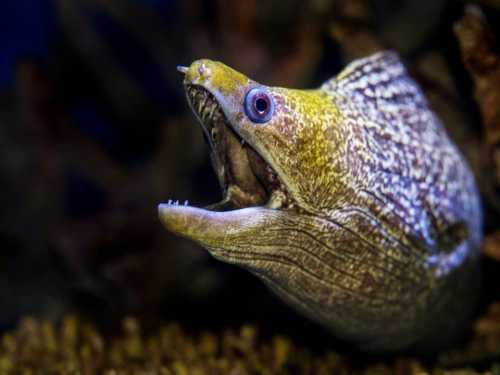
Yes, friends, a moray eel is not your ordinary eel. This underwater introvert is not as simple as it seems. This monster lives among the rocks, only occasionally sticking out its gloomy muzzle to chase away cheerful colorful fish from its hole or to bite them. And, of course, if you, the reader, had the same expression on your face, then you, like her, would only go outside at night. Which, in fact, she does.
In essence, a moray eel is like a sea eel. It hunts by surprise at night, although it can be active during the day if the opportunity arises. It eats almost anything it comes across, not disdaining even essentially harmless crustaceans and mollusks, which, by the way, its truly huge teeth allow it to do.
By the way, about teeth. The mouth of a moray eel is something. It is a real hotbed of a wide variety of pathogenic bacteria, and the moray eel's teeth are slightly twisted inward. But not only the mouth has such a structure! The moray eel has another secret weapon hidden deeper – a second pair of jaws! Yes, like a xenomorph from a horror movie, the moray eel extends this inner jaw with sharp teeth to pull the prey straight into its throat. This is not a fish, this is a real predatory mechanism that leaves the victim no chance of salvation!
As a result, we get that the bite of a moray eel is extremely painful. Some careless diver can easily get a deep laceration. But these are flowers. Bacteria that enter the blood with saliva cause serious infection. And if help is not provided in time, this abomination can lead to sepsis, and then to fatal consequences not far off.
By the way, despite their sinister reputation and their constantly open mouth (which, by the way, they keep not for aggression, but simply to breathe and pass water through their gills!), moray eels are not very aggressive creatures. They usually attack only when they feel in danger, or if someone carelessly sticks their hand into their hole, mistaking it for something else. So, if you don't annoy the “gopnik” and don't climb up to him, the chances of peaceful coexistence are quite high.
Phew, let's continue. Another unusual feature of moray eels is the lack of a tongue like a human and two pairs of nostrils. The nostrils of moray eels are elongated into short tubes and are not intended for breathing, but only for smelling. And their body is covered with thick, smooth skin without scales.
They are found only in warm, salty waters. The greatest species diversity of moray eels has been achieved in the Red Sea and the Indian Ocean. They are also found in the Mediterranean Sea, the Atlantic Ocean and some parts of the Pacific Ocean. They settle mainly at shallow depths: in coral reefs and rocky shallows. Although most species hang out on the shallows, some extreme ones dive hundreds or even thousands of meters deep!
And speaking of size, not all moray eels are the same! There are tiny beauties only 15 centimeters long, hiding in the crevices of corals, and there are real sea giants. Some species, for example, the giant moray eel, can grow up to three meters long and weigh under a hundred kilograms! Can you imagine such a “gopnik” waiting for you in a dark crevice? This is no joke! And some species can crawl on land during low tide, just like snakes.
The reproduction of moray eels has not been fully studied in our time. That's the way it is, in general… It is sometimes not clear whether it is a moray or a mureniha, because these amazing creatures probably often swam somewhere in the area of Thailand, and now some species are able to consistently change sex. Moray eels' larvae are called leptocephali, like eel larvae. Their babies have a transparent body and reach sizes of 7-10 cm.
Oh, by the way, the ancient Romans really liked to snack on this person and served moray eels at banquets. They say they even learned how to breed them in captivity. But it seems that since the times of Rome, the fashion for moray eels has passed a little. Although the recipes have not gone anywhere, today it is more of an exotic delicacy that can be tried in some tropical countries, and not a dish for every day.
But, despite their sinister appearance and predatory nature, moray eels are not always the only owners in their “habitats”. Imagine, they do not disdain the services of the so-called “cleaner fish”! These little helpers swim right into the moray eels' mouth, cleaning parasites and food debris between their teeth. A kind of marine dentistry! This proves once again that the underwater world is much more complex and interesting than it seems at first glance.





